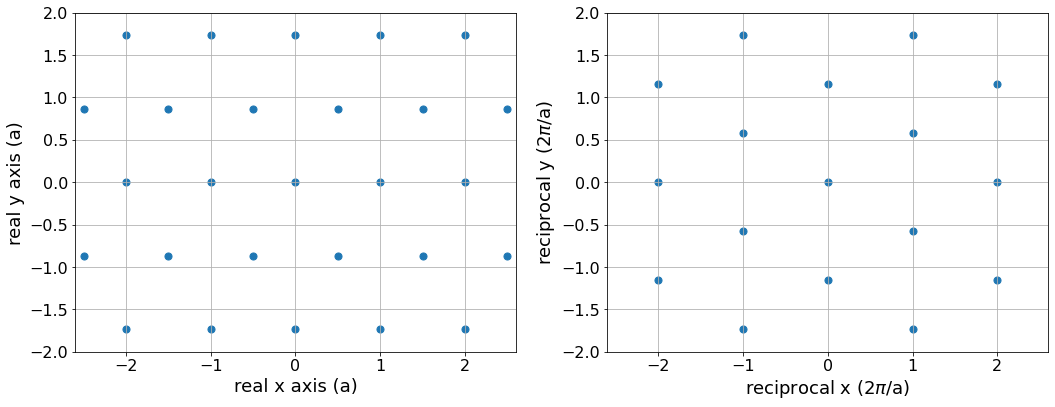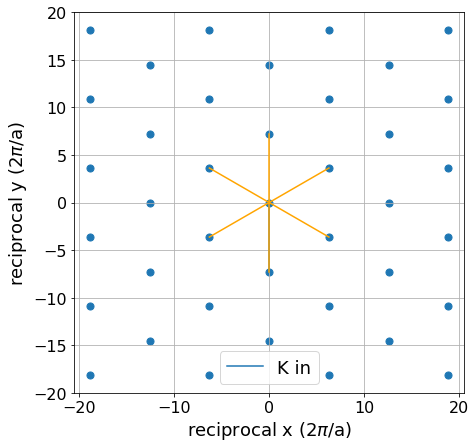Problem 1 - Answers¶
Consider a 2D triangle lattice with basis vectors \(\mathbf{a}_1 = (a, 0)\) and \(\mathbf{a}_2 = (1/2, \sqrt{3}/2)a\).
Calculate the reciprocal lattice vectors for this lattice. Plot the lattice in real space and reciprocal space.
import numpy as np
from matplotlib import pyplot as plt
a = 1 # Take a=1 we will work in units of a so this is arbitrary
a1 = np.array([a, 0, 0])
a2 = np.array([0.5 * a, np.sqrt(3)/2 * a, 0])
a3 = np.array([0, 0, 1])
denominator = np.dot(a1, np.cross(a2, a3))
b1 = 2*np.pi * (np.cross(a2, a3))/denominator
b2 = 2*np.pi * (np.cross(a3, a1))/denominator
b3 = 2*np.pi * (np.cross(a1, a1))/denominator
print(a1, a2, a3)
print(b1, b2, b3)
[1 0 0] [0.5 0.8660254 0. ] [0 0 1]
[ 6.28318531 -3.62759873 0. ] [0. 7.25519746 0. ] [0. 0. 0.]
lattice_size = 10
axis_size = 2
# Construct the lattice by running through every combination of lattice vectors in x and y
combinations = np.array(np.meshgrid(range(-lattice_size, lattice_size), range(-lattice_size, lattice_size))).reshape(2, -1)
real_lattice = np.empty_like(combinations, dtype=float)
recip_lattice = np.empty_like(combinations, dtype=float)
for i in range(np.shape(real_lattice)[-1]):
real_lattice[:,i] = combinations[0,i] * a1[0:2] + combinations[1,i] * a2[0:2]
recip_lattice[:,i] = combinations[0,i] * b1[0:2] + combinations[1,i] * b2[0:2]
params = {
'axes.labelsize': 18,
'font.size': 18,
'legend.fontsize': 18,
'xtick.labelsize': 16,
'ytick.labelsize': 16,
'figure.figsize': [15, 6]
}
plt.rcParams.update(params)
fig, [ax1, ax2] = plt.subplots(nrows=1, ncols=2)
ax1.scatter(real_lattice[0,:], real_lattice[1,:], s=50)
ax1.axis('equal')
ax1.grid()
ax1.set(xlim=[-axis_size*a, axis_size*a], ylim=[-axis_size*a, axis_size*a],
xlabel = "real x axis (a)",
ylabel = "real y axis (a)")
ax2.scatter(recip_lattice[0,:] / (2*np.pi/a), recip_lattice[1,:] / (2*np.pi/a), s=50)
ax2.axis('equal')
ax2.grid()
ax2.set(xlim=[-axis_size*a, axis_size*a], ylim=[-axis_size*a, axis_size*a],
xlabel = "reciprocal x (2$\pi$/a)",
ylabel = "reciprocal y (2$\pi$/a)")
fig.tight_layout()
plt.show()

Consider a photon incident on the lattice with wavevector \(\mathbf{k}_{in} = [0, 4\pi/\sqrt{3}a]\). Find the possible outgoing wavevectors for elastic scattering of the photon from this lattice and plot them on the reciprocal lattice.
\(\mathbf{k}_{out}\) can be found using
\[ \mathbf{k}_{out} = \mathbf{k}_{in} + \mathbf{G}, \]
where \(\mathbf{G}\) is any reciprocal lattice vector
\[ 2\mathbf{k}_{in} \cdot \mathbf{G} + \mathbf{G}^2 = 0.\]
So we need to loop through all reciprocal lattice vectors and test this condition.
k_in = np.array([0, 4*np.pi/(np.sqrt(3)*a)])
axis_size = 20
k_out = []
for i in range(np.shape(recip_lattice)[-1]):
G = recip_lattice[:,i]
product = np.dot(2*k_in, G)
G_square = np.dot(G, G)
if product + G_square == 0:
k_out_temp = k_in + G
k_out.append(k_out_temp)
# PLot reciprocal lattice
params = {
'figure.figsize': [7, 7]
}
plt.rcParams.update(params)
fig3, ax3 = plt.subplots(nrows=1, ncols=1)
ax3.scatter(recip_lattice[0,:], recip_lattice[1,:], s=50)
ax3.axis('equal')
ax3.grid()
ax3.set(xlim=[-axis_size*a, axis_size*a], ylim=[-axis_size*a, axis_size*a],
xlabel = "reciprocal x (2$\pi$/a)",
ylabel = "reciprocal y (2$\pi$/a)")
fig.tight_layout()
# Plot k_in and k_out
ax3.plot([0, -k_in[0]], [0, -k_in[1]], label="K in") # K-in must end at a lattice point
for k in k_out:
ax3.plot([0, -k[0]], [0, -k[1]], color="orange")
ax3.legend()
plt.show()

